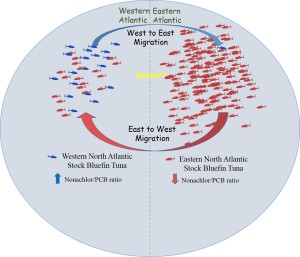NOAA funded project (co-PI with PI, Dr. John Graves, Virginia Institute of Marine Science): “Use of Organochlorine Tracer Analysis to Determine the Magnitude and Temporal Variation of Mixing Rates of Eastern and Western School Size Bluefin Tuna in the Western Atlantic Recreational Fishery for School Bluefin Tuna”.
This project examined the extent of movements of school-sized (ages 1-4) bluefin tuna between western North Atlantic (waters off the coastal United States) and eastern North Atlantic (Mediterranean Sea) using organochlorine pollutant compounds as biogeochemical tracers for their recent (within 1 year) diet and therefore, habitat use. Because of differences in historical pollutant use in the United States and Europe, tuna accumulate organochlorine pollutants (PCBs and nonachlor pesticides) at different ratios.
Fish who have recently foraged in the Mediterranean and migrated across the Atlantic (red fish in the left portion of the figure above) can be identified as recent migrants to the western Atlantic via analysis of the relative amounts of the organochlorine pollutants that have accumulated in their muscle tissue. Approximately, 30% of school-aged bluefin tuna caught in the western Atlantic are recent migrants. The much larger population size of the eastern Atlantic stock limits our ability to observe west to east migrant fish (i.e., the probability of catching the one blue fish in the right portion of the graph above is very low). This novel technique provides a relatively inexpensive way to measure stock mixing for this commercially important fish species with significant implications for its international management.
While the majority of my recent research has concentrated on the molecular characterization of aerosol organic matter, this type of study applying biogeochemical tracers (e.g., pollutants, isotopes, biomarker compounds) to answer ecological questions (e.g., fish movements, diet, habitat use) remains a research interest.





Recent Comments